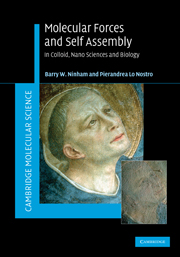Book contents
- Frontmatter
- Contents
- Preface
- Part I Molecular forces
- Part II Self assembly
- 9 Self assembly: overview
- 10 Self assembly in theory and practice
- 11 Bicontinuous phases and other structures: forces at work in biological systems
- 12 Emulsions and microemulsions
- 13 Forces at work: a miscellany of issues
- Index
- References
12 - Emulsions and microemulsions
from Part II - Self assembly
Published online by Cambridge University Press: 06 January 2011
- Frontmatter
- Contents
- Preface
- Part I Molecular forces
- Part II Self assembly
- 9 Self assembly: overview
- 10 Self assembly in theory and practice
- 11 Bicontinuous phases and other structures: forces at work in biological systems
- 12 Emulsions and microemulsions
- 13 Forces at work: a miscellany of issues
- Index
- References
Summary
Emulsions
When a third component, ‘oil’, is added to a mixture of surfactants and water, the system can form an emulsion. The ‘oil’ can be any predominantly hydrophobic solution or solid paraffin particles that phase-separate from ‘water’ without surfactant. The ‘surfactant’ can include any amphiphilic materials like proteins or long-chain alcohols. The hydrophilic part can be water or another liquid, and can contain salts, sugars, whatever. So the term emulsion, including foods, cosmetics, lubricants, drug delivery, etc., embraces if we like an entire major phylum in the Chemical Kingdom.
Here the ‘surfactant’ adsorbs at the water–oil interface to segregate ‘oil’ from ‘water’ into macroscopic pools. The surfactant adsorbed can be a monolayer, or it can consist of multiple layers. Because of their size, emulsions usually scatter light and appear opaque. The pools of water in oil, or of oil in water, often contain within them smaller oil–water–surfactant microstructures. Sometimes they are bicontinuous. Emulsions are mostly thermodynamically unstable. That is, the droplets will coalesce with time. It used to be thought that the formation of emulsions always required work, such as stirring or sonication, but this is not so. Some, as we shall see, form spontaneously and are thermodynamically stable systems that exist as an apparent single ‘phase’ with complicated microstructure.
With ionic surfactants, electrostatic double-layer forces act to oppose coalescence of droplets. Depletion forces (see Chapter 4) due to micelles in water are probably even more effective in stabilizing emulsions.
- Type
- Chapter
- Information
- Molecular Forces and Self AssemblyIn Colloid, Nano Sciences and Biology, pp. 329 - 347Publisher: Cambridge University PressPrint publication year: 2010



